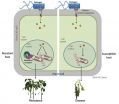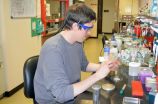(Press-News.org) Hamilton, ON (May 21, 2015) - Scientists at McMaster University have discovered how to make adult sensory neurons from human patients simply by having them roll up their sleeve and providing a blood sample.
Specifically, stem cell scientists at McMaster can now directly convert adult human blood cells to both central nervous system (brain and spinal cord) neurons as well as neurons in the peripheral nervous system (rest of the body) that are responsible for pain, temperature and itch perception. This means that how a person's nervous system cells react and respond to stimuli, can be determined from his blood.
The breakthrough, published online today and featured on the cover of the journal Cell Reports, was led by Mick Bhatia, director of the McMaster Stem Cell and Cancer Research Institute. He holds the Canada Research Chair in Human Stem Cell Biology and is a professor in the Department of Biochemistry and Biomedical Sciences of the Michael G. DeGroote School of Medicine. Also playing a key role was Karun Singh, a co-author in the study and holder of the David Braley Chair in Human Stem Cell Research.
Currently, scientists and physicians have a limited understanding of the complex issue of pain and how to treat it. The peripheral nervous system is made up of different types of nerves - some are mechanical (feel pressure) and others detect temperature (heat). In extreme conditions, pain or numbness is perceived by the brain using signals sent by these peripheral nerves.
"The problem is that unlike blood, a skin sample or even a tissue biopsy, you can't take a piece of a patient's neural system. It runs like complex wiring throughout the body and portions cannot be sampled for study," said Bhatia.
"Now we can take easy to obtain blood samples, and make the main cell types of neurological systems - the central nervous system and the peripheral nervous system - in a dish that is specialized for each patient," said Bhatia. "Nobody has ever done this with adult blood. Ever.
"We can actually take a patient's blood sample, as routinely performed in a doctor's office, and with it we can produce one million sensory neurons, that make up the peripheral nerves in short order with this new approach. We can also make central nervous system cells, as the blood to neural conversion technology we developed creates neural stem cells during the process of conversion."
His team's revolutionary, patented direct conversion technology has "broad and immediate applications," said Bhatia, adding that it allows researchers to start asking questions about understanding disease and improving treatments such as: Why is it that certain people feel pain versus numbness? Is this something genetic? Can the neuropathy that diabetic patients experience be mimicked in a dish?
It also paves the way for the discovery of new pain drugs that don't just numb the perception of pain. Bhatia said non-specific opioids used for decades are still being used today.
"If I was a patient and I was feeling pain or experiencing neuropathy, the prized pain drug for me would target the peripheral nervous system neurons, but do nothing to the central nervous system, thus avoiding non-addictive drug side effects," said Bhatia.
"You don't want to feel sleepy or unaware, you just want your pain to go away. But, up until now, no one's had the ability and required technology to actually test different drugs to find something that targets the peripheral nervous system and not the central nervous system in a patient specific, or personalized manner."
Bhatia's team successfully tested their process using fresh blood, but also cryopreserved (frozen) blood. Since blood samples are taken and frozen with many clinical trials, this allows them "almost a bit of a time machine" to go back and explore questions around pain or neuropathy to run tests on neurons created from blood samples of patients taken in past clinical trials where responses and outcomes have already been recorded".
In the future, the process may have prognostic potential, explained Bhatia, in that one might be able to look at a patient with Type 2 Diabetes and predict whether they will experience neuropathy by running tests in the lab using their own neural cells derived from their blood sample.
"This bench to bedside research is very exciting and will have a major impact on the management of neurological diseases, particularly neuropathic pain," said Akbar Panju, medical director of the Michael G. DeGroote Institute for Pain Research and Care, a clinician and professor of medicine.
"This research will help us understand the response of cells to different drugs and different stimulation responses, and allow us to provide individualized or personalized medical therapy for patients suffering with neuropathic pain."
INFORMATION:
This research was supported by the Canadian Institutes of Health Research, Ontario Institute of Regenerative Medicine, Marta and Owen Boris Foundation, J.P. Bickell Foundation, and the Ontario Brain Institute and Brain Canada.
Editors: Interview and b-roll clips, photographs and illustrations may be found at: http://fhs.mcmaster.ca/media/blood_into_neural_tissue/
For more information:
Veronica McGuire
Media Relations
Faculty of Health Sciences
McMaster University
vmcguir@mcmaster.ca
905-525-9140, ext. 22169
One of the reasons pluripotent stem cells are so popular in medical research is that they can be differentiated into any cell type. However, typical differentiation protocols lead to a heterogeneous population from which the desired type must be purified. Normally, antibodies that react to surface receptors unique to the desired cell are used for this purpose. However, in many cases the purification levels remain poor and the cells can be damaged. New RNA technology produced at CiRA may avoid these problems.
Professor Hirohide Saito at the Dept. of Reprogramming Science ...
Receptors carrying built-in decoys are the latest discovery in the evolutionary battle between plants and pathogens. The decoy domains within the receptor detect pathogens and raise the cell's alarm when there is an infection.
Plants display component parts of their immune system on receptors to trick pathogens into binding with them, which then triggers defence mechanisms. The discovery comes from Professor Jonathan Jones' group at The Sainsbury Laboratory, published in the high-impact journal Cell with a companion paper on a similar discovery from the Deslandes group ...
Almost 90 per cent of men with advanced prostate cancer carry genetic mutations in their tumours that could be targeted by either existing or new cancer drugs, a landmark new study reveals.
Scientists in the UK and the US have created a comprehensive map of the genetic mutations within lethal prostate cancers that have spread around the body, in a paper being hailed as the disease's 'Rosetta Stone'.
Researchers say that doctors could now start testing for these 'clinically actionable' mutations and give patients with advanced prostate cancer existing drugs or drug combinations ...
May 21, 2015 - A University of Wyoming faculty member led a research team that discovered a certain type of soil bacteria can use their social behavior of outer membrane exchange (OME) to repair damaged cells and improve the fitness of the bacteria population as a whole.
Daniel Wall, a UW associate professor in the Department of Molecular Biology, and others were able to show that damaged sustained by the outer membrane (OM) of a myxobacteria cell population was repaired by a healthy population using the process of OME. The research revealed that these social organisms ...
When Dolphin was a typhoon on May 16, NASA's CloudSat satellite completed a stunning eye overpass of Typhoon Dolphin in the West Pacific at 0412 UTC (12:12 a.m. EDT). By May 22, Dolphin's remnants were moving through the Northern Pacific.
NASA's CloudSat satellite sends pulses of microwave energy through the clouds, and some of the energy in the pulses is reflected back to the spacecraft. The time delay between when the pulse is sent and when the reflected energy is received back at the spacecraft is mapped into a distance of the cloud from the surface of the Earth, and ...
COLUMBIA, Mo. - Last year, researchers at the University of Missouri published a study on genetic diversity in American black bears in Missouri, Arkansas and Oklahoma and determined that conservation management is needed to maintain healthy populations in the region. Now, those scientists have expanded the study to include black bears throughout North America. They discovered that black bears in Alaska are more closely related to bears in the eastern regions of the U.S. and Canada than those located in western regions. Details from the study revealed ancient movement patterns ...
(PARIS, FRANCE) - Stent thrombosis following urgent angioplasty for acute heart attack occurred in less than 1% of patients in a large, "real-world" registry, regardless of whether the antithrombotic treatment used during the procedure was bivalirudin, heparin alone, or a GP IIb/IIIa inhibitor (typically in combination with heparin).*
However, patients who experienced a stent thrombosis between days 2 and 30, regardless of drug regimen, were more likely to die within one year than were patients who developed stent thrombosis within the first 24 hours of their procedure.
"What ...
Skin pliability and elasticity improved after treatment with onabotulinum toxin (Botox) for mild facial wrinkles and the effect lasted for up to four months, according to a report published online by JAMA Facial Plastic Surgery.
Human skin has three biomechanical features: strength, pliability (the ability to stretch) and elasticity (the ability to recoil). As people age, these properties change and the loss of skin elasticity appears to be the most prominent. Physicians use a variety of methods to reverse the signs of aging and onabotulinum toxin A injections are among ...
Providing personalized education and risk assessment for patients with diabetes when they visit the ophthalmologist did not improve glycemic control as measured by hemoglobin A1c levels compared with patients who received usual care, according to a study published online by JAMA Ophthalmology.
Intensive blood glucose control can reduce the onset and progression of microvascular complications in people with diabetes. However, optimal glycemic control as measured by HbA1c is notoriously difficult to achieve. A potential strategy to improve glycemic control is to leverage ...
A workplace intervention designed to reduce employees' work-family conflict and increase schedule flexibility also has a positive influence on the sleep patterns of the employees' children.
The intervention, Support-Transform-Achieve-Results (STAR), includes training supervisors to be more supportive of their employees' personal and family lives, changing the structure of work so that employees have more control over their work time, and changing the culture in the workplace so that colleagues are more supportive of each other's efforts to integrate their work and personal ...



